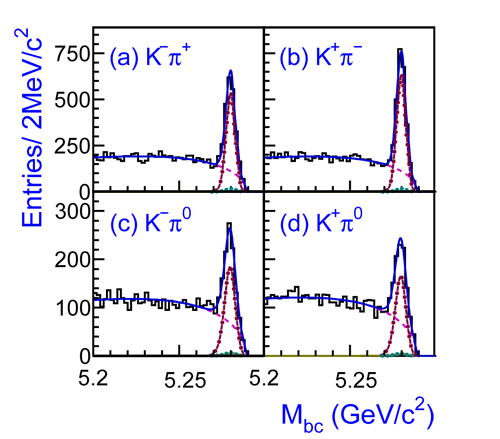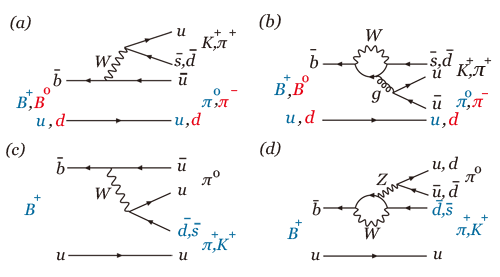The Belle collaboration, an international research group working at the KEKB accelerator of High Energy Accelerator Research Organization (KEK) in Japan, observed a difference between direct charge-parity (CP) asymmetries for charged and neutral B meson decays into a kaon and a pion. Although it is susceptible to strong interaction effects, this difference could be an indication of a new source of CP violation that is needed to explain the matter-dominated Universe. The Belle result has been accepted for publication by Nature; this is the first time that experimental results from a B factory have been published in Nature.
Equal amounts of matter and antimatter were expected to be produced after the Big Bang, but our Universe is clearly matter-dominated. One of the prerequisites to explain the absence of antimatter is the violation of CP symmetry, a difference in the elementary properties of matter and antimatter. So far CP violation has been established only in the K0 and B0 meson systems, with larger effects in the latter. However, experimental results are still consistent with the mechanism proposed by Kobayashi and Maskawa, which has a unique source of CP violation that is known to be too small to explain the elimination of antimatter.
Since the effect of CP violation is very small, large quantities of data are needed to search for CP violation. In the early 21st century two experiments were dedicated to this purpose: the Belle experiment at KEK and the BaBar experiment at the Stanford Linear Accelerator Center in the USA. In 535 million  pairs, Belle observes 2241 pairs, Belle observes 2241 57 K+ 57 K+ - and 1856 - and 1856  52 K - 52 K - + signal events. A clear height difference can be seen in Figs.1(a) and 1(b), a signature of CP violation indicating that the B0 meson has a higher decay rate to K + signal events. A clear height difference can be seen in Figs.1(a) and 1(b), a signature of CP violation indicating that the B0 meson has a higher decay rate to K . With . With    0 signal events, more K - 0 signal events, more K - 0 signal events are observed, which is also visible as a height difference in Figs.1(c) and 1(d). However, this height deviation in the charged B sample is the opposite of that in Figs.1(a) and 1(b), suggesting different CP violation effects in charged and neutral B mesons. Our result is consistent with the previous measurements from Belle and BaBar but is more precise. 0 signal events are observed, which is also visible as a height difference in Figs.1(c) and 1(d). However, this height deviation in the charged B sample is the opposite of that in Figs.1(a) and 1(b), suggesting different CP violation effects in charged and neutral B mesons. Our result is consistent with the previous measurements from Belle and BaBar but is more precise.
What causes the difference of the CP asymmetry is still uncertain. Since the dominant contributions to the B K K decay are from diagrams (a) and (b) in Fig.2, one would naively expect similar CP asymmetries for charged and neutral B decays. The large observed deviation may be explained by strong interaction effects (Fig.2(c)) or new physics (Fig.2(d)). However, the former explanation may indicate a breakdown of theoretical understanding in B meson decays. decay are from diagrams (a) and (b) in Fig.2, one would naively expect similar CP asymmetries for charged and neutral B decays. The large observed deviation may be explained by strong interaction effects (Fig.2(c)) or new physics (Fig.2(d)). However, the former explanation may indicate a breakdown of theoretical understanding in B meson decays.
To understand whether new physics is indeed involved in the B K K decay, study of CP violations from other modes is needed. For instance, decay modes governed dominantly by the mechanism in Fig.2(b), the decay B0 decay, study of CP violations from other modes is needed. For instance, decay modes governed dominantly by the mechanism in Fig.2(b), the decay B0 K0 K0 0 and mixing in the 0 and mixing in the  system are good candidates. Current experimental measurements on CP violation for these candidates are not precise enough. Much more data are needed. Searching for new physics in CP violation will be one of the major goals of the B factory upgrade at KEK and other future B physics facilities. system are good candidates. Current experimental measurements on CP violation for these candidates are not precise enough. Much more data are needed. Searching for new physics in CP violation will be one of the major goals of the B factory upgrade at KEK and other future B physics facilities.
Original Paper: Nature 452, 332-335 (20 March 2008)
[ Media Contact ] Youhei Morita, KEK Public Relations Office
+81 29-879-6047
|
 |
Figure 1 : Mbc (left) projections for (a) K - +, (b) K+ +, (b) K+ -, (c) K - -, (c) K - 0 and (d) K+ 0 and (d) K+ 0. Histograms are data, solid curves are the fit projections, point-dashed lines are the signal components, dashed lines are the continuum background, and dotted lines are the 0. Histograms are data, solid curves are the fit projections, point-dashed lines are the signal components, dashed lines are the continuum background, and dotted lines are the   signals that are misidentified as signals that are misidentified as   . (Figures are taken from the Nature Letter 06827.) . (Figures are taken from the Nature Letter 06827.)
|
 |
Figure 2 : Feynman diagrams for B K K , ,  . B+(B0) meson consists of a . B+(B0) meson consists of a  quark and a u(d) quark while its antiparticle, B -( quark and a u(d) quark while its antiparticle, B -( 0) is made of a b quark and a 0) is made of a b quark and a  ( ( ) quark. Contributions from diagrams (a) and (b) are expected to be dominant over those from (c) and (d). (Figures are taken from the Nature Letter 06827.) ) quark. Contributions from diagrams (a) and (b) are expected to be dominant over those from (c) and (d). (Figures are taken from the Nature Letter 06827.)
|
|



